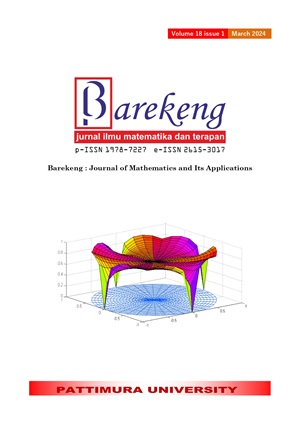STATISTICAL MODELING OF TOURISM INVESTMENT DECISIONS IN INDONESIA USING SEMIPARAMETRIC APPROACH
Abstract
The tourism potential in Indonesia is very large considering that Indonesia consists of tens of thousands of separate islands. Indonesia has many diverse landscapes, with all its nature wealth and biodiversity in it is an attraction for investors who want to invest in Indonesia. The existence of relationships between variables that are linear and nonlinear, where no nonlinear pattern is known, requires a semiparametric approach. This study aims to apply a semiparametric approach to model people's investment decisions in tourism in Indonesia. The data used is in the form of respondents from investors who invest in tourism in Indonesia from the 2022 National Competitive Basic Research (PDKN) as many as 100 respondents. This study uses the semiparametric path analysis method to model tourism investment decisions in Indonesia. The results show that regulatory variables and investment interest variables have a significant and positive effect on investment decision variables. A diversity coefficient of 60.2% indicates that data diversity can be explained by 60.2% with models, while other variables outside the study explain the remaining 38.8%. In other words, the regulatory variable (X) and the investment interest variable (Y1) can influence the investment decision variable (Y2) by 60.2%.
Downloads
References
D. Wahyuni, I. K. P. Sari, A. Prasetio, and M. Berlianaldo, “Environmental Sustainability Analysis in the Tourism Sector: A Perspective on Resilient and Sustainable Tourism Development in Indonesia,” 2023. [Online]. Available: https://www.researchgate.net/publication/372405393
M. Artaya, I. Bagus, A. Purbawangsa, L. Gede, and S. Artini, “Pengaruh Faktor Ekonomi Makro, Risiko Investasi dan Kinerja Keuangan Terhadap Return Saham Perusahaan di Bursa Efek Indonesia (BEI),” 2014.
Y. R. O. Mandagie, M. Febrianti, and L. Fujianti, “Studi Kasus Mahasiswa Akuntansi Universitas Pancasila,” 2020. [Online]. Available: http://journal.univpancasila.ac.id/index.php/RELEVAN
M. Rus’an Yasin, M. Akbar, M. Y. Hasmin, and B. I. Hukum, “Kewenangan Ombudsman dalam Penanganan Laporan Pelayanan Publik Ombudsman’s Authority in Handling Reports Public Service,” Jurnal Kolaboratif Sains, vol. 4, no. 5, pp. 241–246, 2021.
A. Mastura, S. Nuringwahyu, and D. Zunaida, “Pengaruh Motivasi Investasi, Pengetahuan Investasi Dan Teknologi Informasi Terhadap Minat Berinvestasi Di Pasar Modal (Studi Pada Mahasiswa Fia Dan Feb Unisma Yang Sudah Menempuh Mata Kuliah Mengenai Investasi),” Jiagabi, vol. 9, no. 1, pp. 64–75, 2020.
A. Nisa and L. Zulaika, “Pengaruh Pemahaman Investasi, Modal Minimal Investasi, dan Motivasi terhadap Minat Mahasiswa Berinvestasi di Pasar Modal,” 2017.
N. Barbieri, C. Ghisetti, M. Gilli, G. Marin, and F. Nicolli, “A Survey of the Literature on Environmental Innovation Based on Main Path Analysis,” Journal of Economic Surveys, vol. 30, no. 3. Blackwell Publishing Ltd, pp. 596–623, Jul. 01, 2016. doi: 10.1111/joes.12149.
A. K. Montoya and A. F. Hayes, “Two-condition within-participant statistical mediation analysis: A path-analytic framework,” Psychol Methods, vol. 22, no. 1, pp. 6–27, Mar. 2017, doi: 10.1037/met0000086.
R. Hidayat and M. Sam, “Model Regresi Nonparametrik dengan Pendekatan Spline Truncated,” Prosiding Seminar Nasional, vol. 03, no. 1, 2018.
M. J. Lai and L. Wang, “Bivariate penalized splines for regression,” Stat Sin, vol. 23, no. 3, pp. 1399–1417, Jul. 2013, doi: 10.5705/ss.2010.278.
Sifriyani, Haryatmi, I. N. Budiantara, and Gunardi, “Geographically weighted regression with spline approach,” Far East Journal of Mathematical Sciences, vol. 101, no. 6, pp. 1183–1196, Mar. 2017, doi: 10.17654/MS101061183.
A. A. R. Fernandes, I. Nyoman Budiantara, B. W. Otok, and Suhartono, “Spline estimator for bi-responses nonparametric regression model for longitudinal data,” Applied Mathematical Sciences, vol. 8, no. 113–116, pp. 5653–5665, 2014, doi: 10.12988/ams.2014.47566.
Z. Awang, W. M. A. Wan Afthanorhan, and M. A. M. Asri, “Parametric and Non Parametric Approach in Structural Equation Modeling (SEM): The Application of Bootstrapping,” Mod Appl Sci, vol. 9, no. 9, Jul. 2015, doi: 10.5539/mas.v9n9p58.
A. Perperoglou, W. Sauerbrei, M. Abrahamowicz, and M. Schmid, “A review of spline function procedures in R,” BMC Medical Research Methodology, vol. 19, no. 1. BioMed Central Ltd., Mar. 06, 2019. doi: 10.1186/s12874-019-0666-3.
B. Xu, Y. Luo, R. Xu, and J. Chen, “Exploring the driving forces of distributed energy resources in China: Using a semiparametric regression model,” Energy, vol. 236, Dec. 2021, doi: 10.1016/j.energy.2021.121452.
S. Ambec, M. A. Cohen, S. Elgie, and P. Lanoie, “The porter hypothesis at 20: Can environmental regulation enhance innovation and competitiveness?,” Rev Environ Econ Policy, vol. 7, no. 1, pp. 2–22, 2013, doi: 10.1093/reep/res016.
P. Bialowolski and D. Weziak-Bialowolska, “External factors affecting investment decisions of companies,” Economics, vol. 8, no. 1, Mar. 2014, doi: 10.5018/economics-ejournal.ja.2014-11.
H. Hasanudin, A. Nurwulandari, and R. K. Safitri, “Pengaruh Pengetahuan Investasi, Motivasi Dan Pelatihan Pasar Modal Terhadap Keputusan Investasi Yang Dimediasi Oleh Minat Investas,” Jurnal Ilmiah Manahemen, Ekonomi, & Akuntansi (MEA), vol. 5, no. 3, pp. 494–512, 2021.
Copyright (c) 2024 Yossy Maynaldi Pratama, Adji Achmad Rinaldo Fernandes, Ni Wayan Surya Wardhani, Nurjannah Nurjannah, Solimun Solimun

This work is licensed under a Creative Commons Attribution-ShareAlike 4.0 International License.
Authors who publish with this Journal agree to the following terms:
- Author retain copyright and grant the journal right of first publication with the work simultaneously licensed under a creative commons attribution license that allow others to share the work within an acknowledgement of the work’s authorship and initial publication of this journal.
- Authors are able to enter into separate, additional contractual arrangement for the non-exclusive distribution of the journal’s published version of the work (e.g. acknowledgement of its initial publication in this journal).
- Authors are permitted and encouraged to post their work online (e.g. in institutional repositories or on their websites) prior to and during the submission process, as it can lead to productive exchanges, as well as earlier and greater citation of published works.






1.gif)



